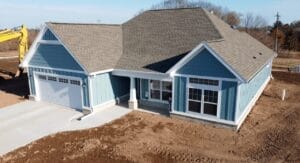Amid soaring costs, city’s cooperation crucial to fitting in enough houses to beat $525,000 price point
Before Mike Howe came to the City of Manitowoc with his idea for the Preserve at Lincoln Park, the last subdivision built in the city a dozen years ago nearly bankrupted its developer.
Today, the 13th of what will eventually be 33 Preserve at Lincoln Park homes is currently under construction in a subdivision unlike any other in Manitowoc. The homes are a little smaller, tighter together and configured on smaller lots to keep the prices mostly under $525,000.
And both Howe and Adam Tegen, the city’s community development director, agree the residential development could not have been built without cooperation unusual for local government.
“This is what good public-private partnership looks like,” Howe says. “I’ve got 10 years of learning to know how to do this. People don’t understand how difficult it is. But the city let me be creative.”
Outside the door to the Community Development Department on the second floor of City Hall, Tegen has posted an adage in a frame from the late Grace Hopper, a computer pioneer and a rear admiral in the U.S. Navy: “The most dangerous phrase in our language is ‘We’ve always done it this way.’”
The placard isn’t to suggest the self-effacing Tegen is wacky or rogue. Manitowoc, blessed with riverfronts and a long Lake Michigan shoreline, is a worker’s city with a shipbuilding history and a study manufacturing base.
It’s just that, when it comes to alleviating what a statewide housing shortage, most communities in the state continue to do it the way they’ve always done it.
There is scant undeveloped farmland left in the city limits. The need for new housing will come from repurposing property such as the Holy Family Memorial Hospital site on Reed Avenue on the west side of Lincoln Park.
Coming out of the pandemic, the City of Manitowoc’s housing study identified a trend recognized around the state: older homeowners staying put because they couldn’t afford sharply spiking home prices.
Soaring property values had made new construction on old sites cost prohibitive, too, Tegen says. When Mike Howe Builders came in with a proposal, and knowing the need for lower cost housing, Tegen says his department was simply open-minded.
“Our mayor (38-year-old Justin Nickels) is progress-minded, he wants the city to grow,” Tegen says. “I can be the most visionary planner in the world, but I just make recommendations. But if the city put its heels in the ground, we were not going to get this done. This was unprecedented.”
Even at the price he paid for the hospital property, which was one-third the price per acre of any other residential land available in the city, Howe says, he needed to put enough homes on it to make a modest profit. The homes are 1,600 square feet to 2,200 square feet.
The property also had to accommodate streets and a stormwater abatement pond. Howe proposed making the streets private at widths narrower than the specifications in the city zoning code, Tegen says. The city agreed to the private streets and, as it has done in other parts of the city, assumed maintenance of the stormwater pond, he says.
“We kept going back at it, doing anything we could to keep the costs down,” Howe says. “These houses had to be affordable — no, attainable. ‘Affordable’ means different things to different people. We have to get rid of that word.”
When the first house in the Preserve went up in March 2023, Howe was touting his 1,600 square-foot home with no basement for $365,000.
That home costs $50,000 more to build two years later. A $475,000 house is now a $525,000 house and the cost of labor and materials continue to rise, Howe says.
So far, those increased costs haven’t been a deterrent. Houses are going up at a steady pace, Howe says. The proximity to water — the Little Manitowoc River on the other side of Lincoln Park, a five-minute drive south to the lakefront marina and Downtown — is a draw for a city not known for its tourism.
Mark and Linda Aulik ended up waiting seven years to get into the Preserve. Both born, raised and retired in Kewaunee, about 30 miles north of Manitowoc, the Auliks sold their home before COVID and settled for renting in Two Rivers as post-pandemic home prices kept them locked out.
They were the fourth homeowners when they moved last June 18. “We timed it about as wrong as you ever could have,” Mark Aulik says. “But when we decided to bite the bullet, we heard about this subdivision. We love it. It’s built on a lot that’s perfect for us. We never built a home before.”
Aulik says he was only generally aware of the back-and-forth between Howe and the city but says he assumes it was necessary for Howe to make a profit and the city to get new housing.
“From the time we first sat down with Mike, we were impressed by the flexibility,” Aulik says. “We made changes and they always said yes. I can’t say enough about Mike and the guys working for him.”
Manitowoc is in the final stages of rewriting its zoning code and, within it, its subdivisions code. Tegen does not envision major changes in zoning for housing. But he expects the new code to be informed by the flexibility shown in the Preserve development.
Howe, whose company has several other projects in the works, was born in Manitowoc. He and his wife, Emily, raised four children, now 17, 19, 21 and 23, here. He never thought of going anywhere else to work or start a business.
To his way of thinking, the Preserve is a way of bringing new people to his hometown. Cooperation with the city, he says, is a way for both parties to leave Manitowoc a better place.
“I’m not afraid to say it, I’m proud to be part of this community.”
Mark Lisheron is the Managing Editor of the Badger Institute.
Any use or reproduction of Badger Institute articles or photographs requires prior written permission. To request permission to post articles on a website or print copies for distribution, contact Badger Institute Marketing Director Matt Erdman at matt@badgerinstitute.org.
Submit a comment
"*" indicates required fields


